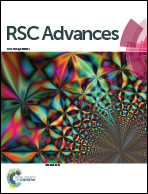Guanine chemiluminescent biosensor capable of rapidly sensing mercury in a sample†
Abstract
Using DNA aptamer and guanine chemiluminescene detection, we developed a highly sensitive biosensor for the rapid quantification and monitoring of Hg2+ in drinking water. The random coil structure of DNA aptamer was transformed to a hairpin-link thymine (T)–Hg2+–T complex, closed by the hybridization of guanine and cytosine of DNA aptamer, in the presence of Hg2+ in drinking water. The brightness of light, emitted from the reaction between guanine of the DNA aptamer and 3,4,5-trimethoxyl phenylglyoxal hydrate (TMPG) in the presence of tetra-n-propylammonium hydroxide (TPA) and O2, exponentially decreased with the increase of Hg2+ due to the transformation of DNA aptamer. The sensitivity of the biosensor was dependent on the incubation time for forming the hairpin-link T–Hg2+–T complex closed by the hybridization of guanine and cytosine of the DNA aptamer. The sensitivity of the biosensor was the highest when DNA aptamer was incubated with Hg2+ for 20 min at room temperature (21 ± 2 °C). The sensitivity of the biosensor generated with incubation longer than 20 min was not as good as that operated with a 20 min incubation because the dehybridization of guanine and cytosine of DNA aptamer is predominant after 20 min. The limit of detection (LOD = CL0 − 3σ) of the biosensor operated with a 20 minute incubation was as low as 2.11 nM. Also, the accuracy, precision, and recovery of the time-dependent biosensor were good within a statistically acceptable error range.


 Please wait while we load your content...
Please wait while we load your content...